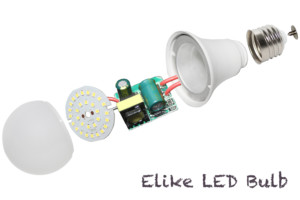Light for life, Exciting for Biz, Design for you.
An LED lamp is a light-emitting diode (LED) product which is assembled into a lamp (or light bulb) for use in lighting fixtures. LED lamps have a lifespan and electrical efficiency which are several times greater than incandescent lamps, and are significantly more efficient than most fluorescent lamps, with some chips able to emit more than 300 lumens per watt (as claimed by Cree and some other LED manufacturers). The LED lamp market is projected to grow by more than twelve-fold over the next decade, from $2 billion in the beginning of 2014 to $25 billion in 2023, a compound annual growth rate (CAGR) of 25%. As of 2016, LEDs use only about 10% of the energy an incandescent lamp requires.
Like incandescent lamps and unlike most fluorescent lamps (e.g. tubes and compact fluorescent lamps or CFLs), LEDs come to full brightness without need for a warm-up time; the life of fluorescent lighting is also reduced by frequent switching on and off. The initial cost of LED is usually higher. Degradation of LED dye and packaging materials reduces light output to some extent over time.
Some LED lamps are made to be a directly compatible drop-in replacement for incandescent or fluorescent lamps. An LED lamp packaging may show the lumen output, power consumption in watts, color temperature in kelvins or description (e.g. “warm white”), operating temperature range, and sometimes the equivalent wattage of an incandescent lamp of similar luminous output.
Most LEDs do not emit light in all directions, and their directional characteristics affect the design of lamps, although omnidirectional lamps which radiate light over a 360° angle are becoming more common. The light output of single LED is less than that of incandescent and compact fluorescent lamps; in most applications multiple LEDs are used to form a lamp, although high-power versions (see below) are becoming available.
LED chips require controlled direct current (DC) electrical power and an appropriate circuit as an LED driver is required to convert the alternating current from the power supply to the regulated voltage direct current used by the LEDs. LEDs are adversely affected by high temperature, so LED lamps typically include heat dissipation elements such as heat sinks and cooling fins.
LED drivers are the essential components of LED lamps or luminaries. A good LED driver can guarantee a long life for an LED system and provide additional features such as dimming and control. The LED drivers can be put inside lamp or luminaire, which is called a built-in type, or be put outside, which is called an independent type. According to different applications, different types of LED drivers need to be applied, for example an outdoor driver for street light, an indoor point driver for a down light, and an indoor linear driver for a panel light.
| Cost Comparison for 60 watt incandescent equivalent light bulb (U.S. residential electricity prices) | ||||||
| Incandescent | Halogen | CFL | LED (Elike Lighting) |
LED (Philips) |
LED (Cree) |
|
| Purchase price | $0.41 | $1.17 | $0.99 | $1.15 | $1.50 | $4.99 |
| Watts | 60 | 43 | 14 | 7 | 8.5 | 9.5 |
| lumens (mean) | 860 | 750 | 775 | 800 | 800 | 815 |
| lumens/watt | 14.3 | 17.4 | 55.4 | 114.3 | 94.1 | 85.8 |
| Color Temperature kelvin | 2700 | 2920 | 2700 | 2700 | 2700 | 2700 |
| CRI | 100 | 100 | 82 | 80 | 80 | 85 |
| Lifespan (hours) | 1,000 | 1,000 | 10,000 | 16,000 | 10,000 | 25,000 |
| Lamp lifetime in years @ 6 hours/day | 0.46 | 0.46 | 4.6 | 7.3 | 4.6 | 11.4 |
| Energy cost over 20 years @ 11 cents/kWh | $289 | $207 | $67 | $34 | $41 | $46 |
| Total cost over 20 years | $307 | $259 | $70 | $37 | $48 | $56 |
| Total cost per 860 lumens | $307 | $297 | $78 | $40 | $52 | $59 |
| Comparison based on 6 hours use per day (43,800 hours over 20 yrs) | ||||||


Leave A Comment